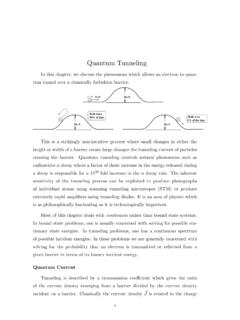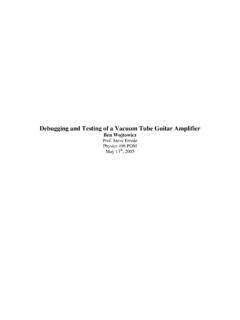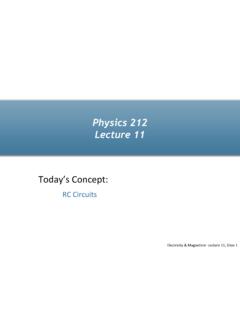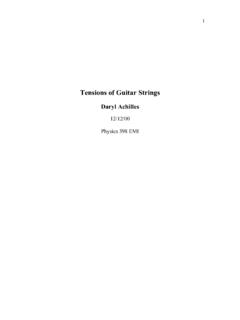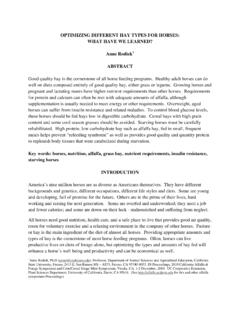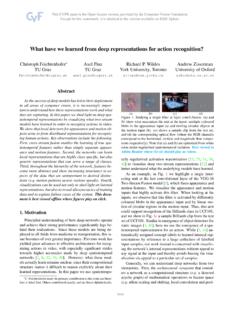Transcription of What Have We Learned? - Course Websites
1 PHYS419 Lecture 28: what have We Learned? 1 what have We Learned? In this lecture, we are going to look back over the content of the Course and try to draw,at the end, a few general conclusions about the relationship of physics to philosophy. Itmay be helpful to cast the discussion in terms of the concept, popularized by the historianof science T. S. Kuhn, of a paradigm . Very crudely and briefly, a paradigm maybe regarded as the overarching conceptual framework that is generally accepted at agiven period in the history of science, and that governs the kinds of question one isallowed to ask and the sorts of answer to them that are regarded as acceptable; inother words, it, as it were, sets the rules for the research that may legitimately becarried out.
2 In Kuhn s thinking, the idea of a paradigm is associated with an importantdistinction between periods of so-called normal science , when a given paradigm reignssupreme, and so-called revolutionary periods, when an old paradigm is challenged andeventually overthrown by a new one. There has been much discussion in the literatureas to how rigid this revolutionary/ normal distinction is, as well as of other aspects ofKuhn s thesis, but it is enough for our general purposes that almost everyone would agreethat, for example, the introduction and eventual acceptance of special relativity and ofquantum mechanics indeed correspond to a Kuhnian revolution in a recognizable senseof the word, and most people would probably also allow that the GRWP theory, if it iseventually accepted, would constitute a new paradigm.
3 Of Course , there are certainlyborderline cases: does the inflationary scenario in cosmology constitute a new paradigm,or is it merely a particularly interesting variant of the existing one? (I would personallyopt for the latter view.) But it is enough for our purposes that a fair number of clear-cutcases this definition, then, it makes sense to look back over the history of physicsas we have traced it in this Course and ask: how did the various paradigms we have metanswer various rather generic questions, and in what ways did the answers (and perhapsthe questions) change in the various revolutions we have reviewed? We will look at fivequestions: what is the nature of space and time?
4 what kinds of things are real ?Which sorts of behavior are natural , and which need explaining? what constitutes an explanation? what exactly is it that makes a theory correct ? The Ghirardi-Rimini-Weber-Pearle attempt to modify QM; see lecture 28: what have We Learned? 2 Space and timeAs we saw, in the Aristotelian picture of the world, the idea of space in general is, in somesense, very much modeled on domestic space: all points are very far from equivalent,and in fact everything has its proper place Earth at the bottom (center), fire at thetop (and ether even farther out). Particularly interesting for the Aristotelian idea ofspace is the assertion that if Earth were somehow displaced from its present position,things would nevertheless gravitate tothatposition and not to the displaced positionof the Earth an absolute reference point par excellence!
5 As to the Aristotelian ideaof time, it seems to have been not that different from the Newtonian one, except lessquantitative (though the Greeks did have devices such as sand-glasses to assure uniformmeasurement of time). Needless to say, there was no concept of any intrinsic connectionbetween time and space, and in particular the only valid reference frame was that tiedto Earth the physics of the 17th-century scientific revolution, the notion of space that even-tually evolved is that formulated explicitly by Newton: an absolute, infinite continuumwith no special reference point (hence the bite of the Leibnizian question: if the Uni-verse is finite, what determines the particular place in space at which it is to be formed?)
6 The idea that there is an absolute measure of space (for any one Galilean observer),though not formulated explicitly, seems essential to Newtonian physics (otherwise wecannot unambiguously define velocities, etc.), but the concept of a standard measuringrod ( ruler ), etc., really comes in much later, with Einstein s analysis. It is interestingthat although, from a twentieth-century point of view, we recognize that Newtonianphysics is not only compatible with, but implies, the concept of Galilean invariance, theidea that all uniformly-moving observers are of equal validity would almost certainlyhave been anathema to Newton himself and to most of his followers although his ab-solute space has no preferred point of reference, it does very definitely have a preferredrest frame (so that it was an important question for Newton what defines this frameand makes it special).
7 In the same way, Newtonian physics incorporates the idea of absolute time, which presumably implies that one has a standard measure such as apendulum clock. However, just as in the case of space, no point in time is special .Recall that these ideas, although strongly emphasized by Newton and his followers, werenot universally accepted in his day in particular, there was strong competition fromthe Leibnizian view that neither space nor time had an absolute existence, but that bothwere relations between objects or relativity, needless to say, drastically modifies the Newtonian picture byrejecting the idea both of absolute space and of absolute time.
8 Of Course , the notionthat neither space nor time has a special reference point ( space- and time-translationinvariance ) is preserved in SR; but now, not only is the actual measure of the spatialdistance between two events dependent on the observer (as was of Course already thecase in Newtonian classical mechanics, though not always recognized or emphasized), Other prescientific cultures seem to have had a rather more anthropocentric concept of time , in Japan, the length of an hour was different during the day and during the 28: what have We Learned? 3but the time interval is also observer-dependent. Indeed, space and time become almostdifferent aspects of the same thing the spacetime interval.
9 With its emphasis on theconcept of events and the space and time intervals between them, SR, at least inEinstein s original formulation, might seem perhaps closer to the Leibnizian than to theNewtonian relativity in some sense knocks the props out even further from the idea ofabsolute space and time, by legitimizing in principle the use of any coordinate systemwhatever (including systems in which, for example, the unit of time is not uniformlyrelated to that measured by a standard pendulum clock). However, there is still aclass of frames in which the equations of motions look particularly simple, namely, theinertial frames; were this all (if, for example, we could forget altogether about gravity),GR would be only a formal generalization of SR allowing us, if preferred, to work in anarbitrary (noninertial) reference frame.
10 The real revolution, of Course , consists in therecognition that the inertial frames are not necessarily those that appear to be so inNewtonian physics, but rather are the freely-falling GR is applied to the Universe as a whole, the picture is further modified:the whole idea of space-time in the absence of matter becomes in some sense dubious,since the very geometry of spacetime is itself determined by matter. This is particularlystriking in the case of a closed Friedmann universe: the whole idea of space outside such a universe, or, for that matter, time before the Big Bang or after the Big Crunch,seems prima facie dubious (but compare the discussion of other universes in lecture27).
